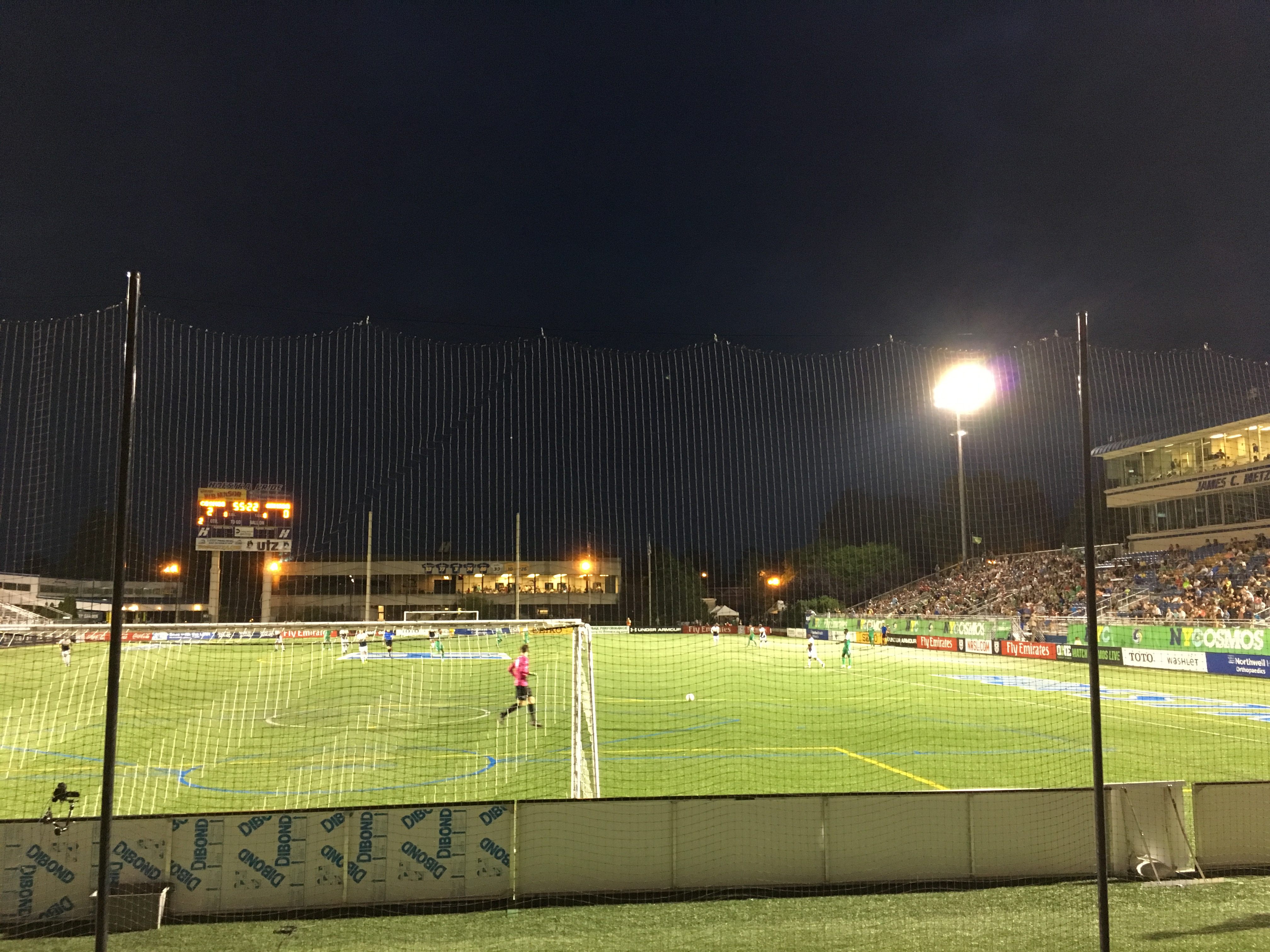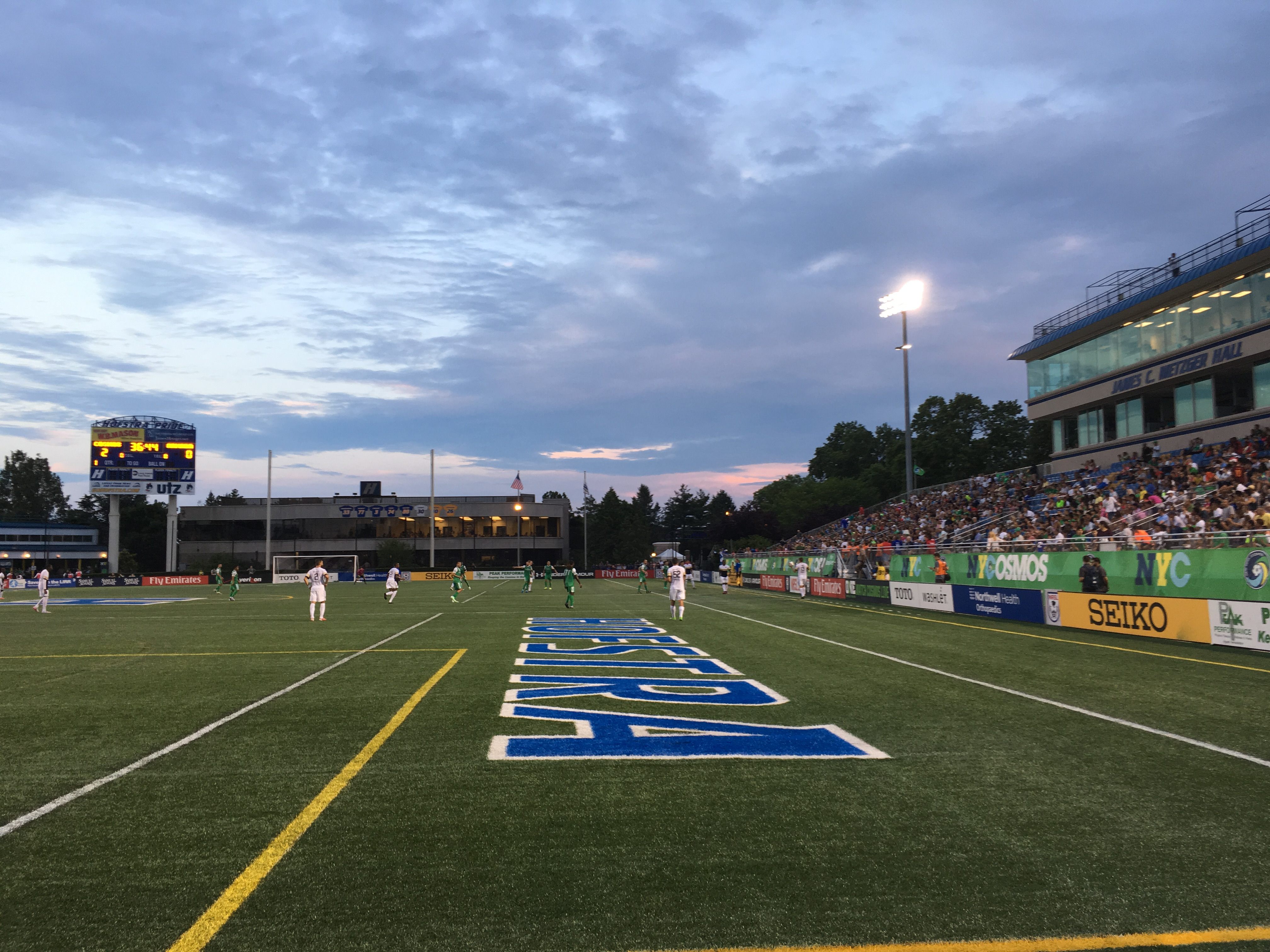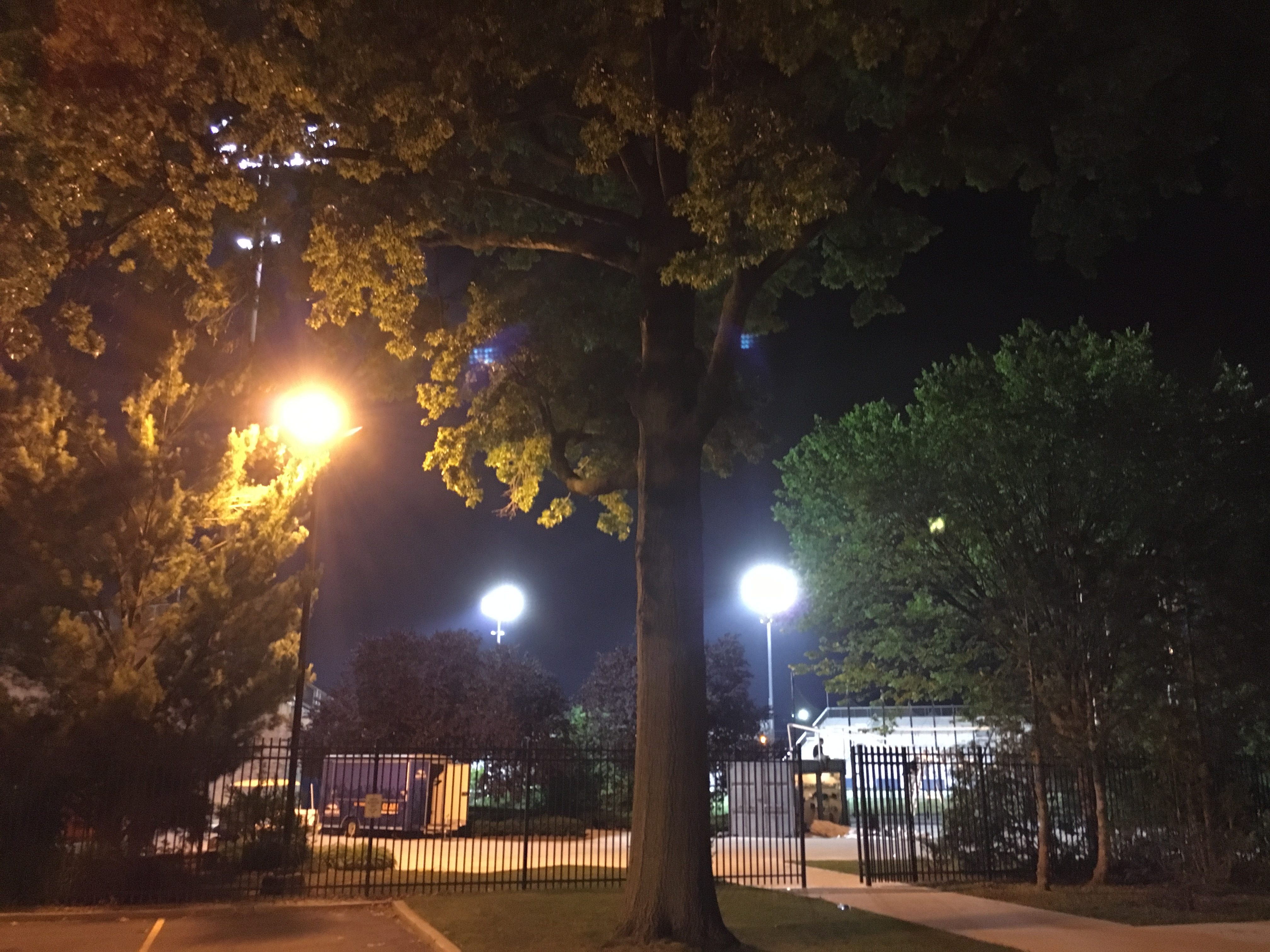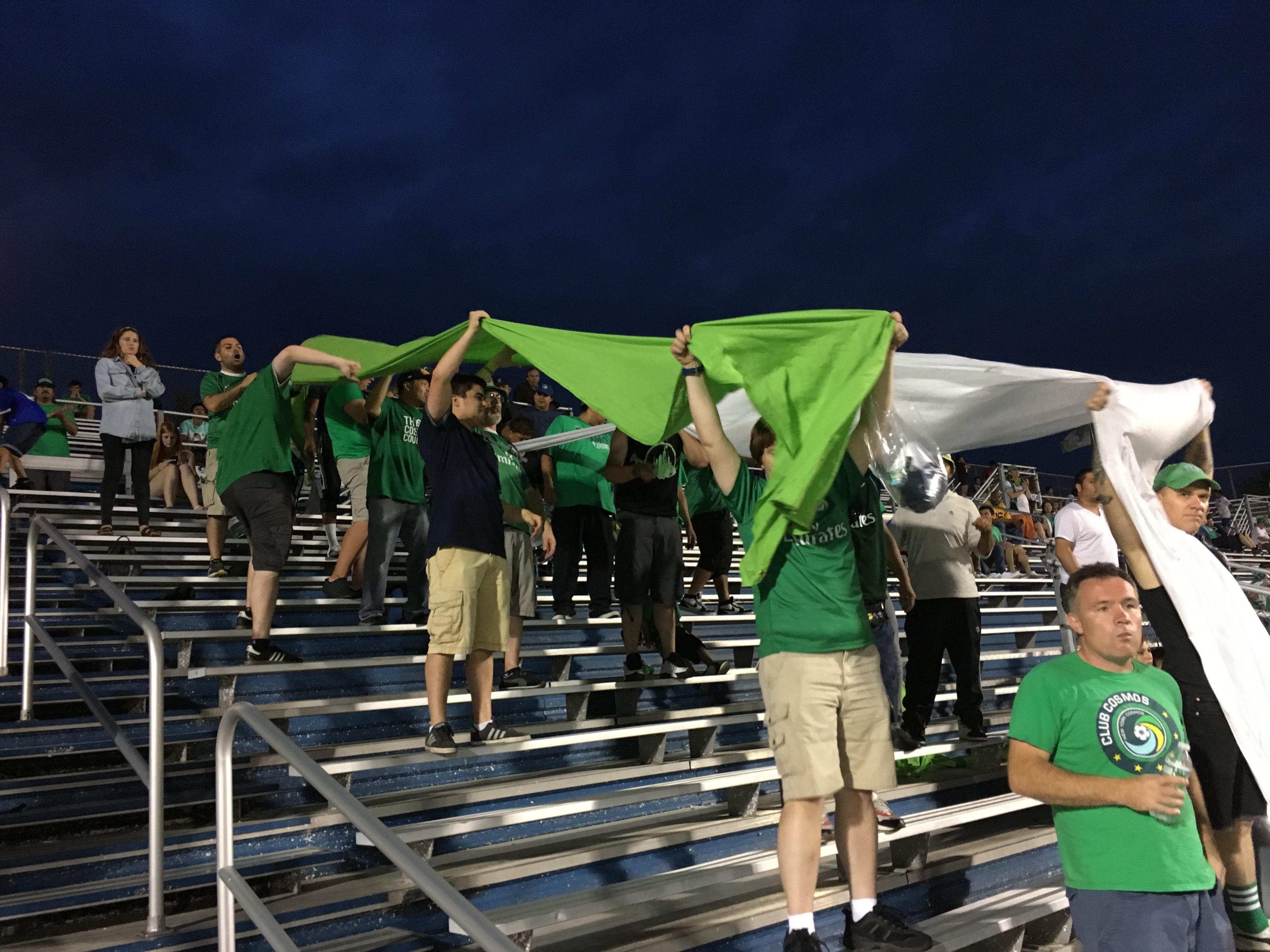The New York Cosmos Are American Soccer’s Past. Are They Its Future?
A team that was once the most glamorous in the world is making its comeback.
Pelé in a game against the Dallas Tornados. (Photo: Focus on Sport/Getty Images)

Many fans on a warm June night at Belson Stadium in Jamaica, New York were clad in strangely dated gear for a soccer game in 2016: a number-10 jersey worn by Pelé, the most celebrated soccer player who ever lived. Pelé became famous in Brazil’s golden era of soccer, winning three World Cups between 1958 and 1970.
But fans weren’t wearing the superstar’s national team shirt, but one from the bookend of his career: Pelé’s brief, if flashy stint at the New York Cosmos, which, for a few short years in the late ‘70s, was the most famous team in the world.

That version of the Cosmos burned a little too brightly, folding in 1985 after winning several North American Soccer League (NASL) titles, but a new version of the team—same colors, vastly lower profile—launched earlier this decade, and, on that evening in June, some of its fans gestured toward their glory years for easy inspiration.
The stakes were high: it was the U.S. Open Cup round of 16, and the Cosmos, a team in the second-tier NASL, were taking on the New England Revolution, a team in the top-tier Major League Soccer (MLS).
The Cosmos had already beaten an MLS team to get to the round of 16, and a second victory would put them into the quarterfinal of a competition that includes 91 teams across the American soccer spectrum. The U.S. Open Cup , in short, is a big deal. Its champion could credibly say that they are the best in the U.S, a claim that might draw snickers from soccer fans in other countries, but for a fledgling team like the Cosmos, and a fledgling league like the NASL, it would be an accomplishment with real meaning.

(All photos by Erik Shilling unless otherwise noted.)
The team’s ultras—the strongest supporters—understood this, banging on drums and singing throughout the game, having shuffled into the game some minutes after kickoff, following a minor uproar at the entrance. Authorities initially wouldn’t allow a massive bass drum and a smaller snare drum to pass through the metal detector.
“Every time,” one (likely less than sober) fan grumbles, before his speech deteriorated into an obscene rant. This is where the Cosmos—who once filled Giants Stadium—have ended up.
This isn’t rock bottom, either. This is a story of hopeful ascendency.
The original Cosmos, the ones you probably remember, peaked in 1977, and attracted global superstars, who came to New York not necessarily for the competition that the NASL offered, but for the glamour. The city might have been broke and crumbling, but in Giants Stadium, during a Cosmos game, the seats were filled. And the crowd roared.
Still, soccer then, in America, wasn’t much more than what it is today: probably sixth or seventh on a list of sports that we would rather be watching, just ahead of things like golf and competitive bowling.
A game of indeterminate origins—some say it was invented in China, others England—the first World Cup was held in 1930, laying the foundations for what is now a worldwide obsession.
Except here, where baseball and football continue to dominate the sports landscape. Among a certain demographic, soccer is still thought of as a sport for “commie pansies,” as an editor at the New York Daily News told soccer writer David Hirshey in the mid-’70s.
Hirshey, who until recently was the executive editor at HarperCollins, was, then, a cub sportswriter. He covered soccer at the News in a time when “American soccer writer” wasn’t really a job. But that also meant he was in pole position to break what was then the biggest story of his journalism career: Pelé, Hirshey reported, was coming to New York.
“Suddenly, I was the envy of my colleagues, covering the biggest sports star in the world and being interviewed by other American journalists about this fellow ‘Peeley,’” Hirshey wrote of the experience.

During a regular season game in July.
In a country obsessed with coach Don Shula’s Miami Dolphins, Pelé became an overnight star. The soccer player’s signing also gave instant credibility to the Cosmos and the NASL, both of which had gotten off to rocky starts just a few years prior.
For Pelé, it was an opportunity to spread the gospel of soccer, while also being an opportunity to spread the gospel of Pelé.
There was also Henry Kissinger.
“He invited me to go to the cafe with him,” Pelé told Esquire earlier this year, “and there he said, ‘Listen. You know I’m from the United States, and I’m in politics there. Soccer is coming along there—they’re playing it in the schools. Would you like to help us promote soccer in the United States?’ And I said, ‘My God.’”
And there was also the money, which amounted to $1.4 million a season, a large amount for a soccer player in America even today. What the Cosmos got for their money was no spring chicken: Pelé was then on the cusp of 35, having already spent 18 years in the Brasileirão, the top Brazilian league. He was well past his prime, but team and player suited each other’s needs well. And in New York, Pelé was a legitimate star, going to Studio 54 at night, mugging for the adoring press corps during the day, and drawing massive crowds at Giants Stadium, where the team played its home games.
Other top players, like the German defender Franz Beckenbauer and the Italian striker Giorgio Chinaglia also soon joined, helping to cap Pelé’s career with one final championship in 1977, one final game against his home club, and then—still on top of the world—retirement.
“There will never be another Cosmos. Big names may come over here eventually — Beckham, Ronaldo, Zidane — but they’ll all be past their prime,” Chinaglia told Hirshey. “We had guys who were at their peak — Beckenbauer, myself, [Johan] Neeskens — and we were on a mission.”
The team became champions of the NASL four times from 1977 to 1982, a dominant stretch in which it was possible to agree that somehow New York had become a soccer town.
Just a few years later, though, in 1984, with the stars gone, the league—struggling at this point—folded. The Cosmos themselves would fold a year later after spending a single season playing indoor soccer.
Professional soccer in the U.S. was dead.
The origins of the modern version of the Cosmos can be traced back to a deal struck four years after the NASL’s demise. In 1988, FIFA agreed to let the U.S. host the 1994 World Cup under the condition that U.S. Soccer again establish a top-tier professional soccer league, what would become the MLS, officially bringing pro soccer back to American soil. In 1996, the league officially started play.

The stands filled at a recent match.
By the turn of the century, soccer in the U.S. had regained much of the foothold it lost when the foreign stars decamped and the money ran out. Broader access to European soccer on television, for one thing, has made the sport more popular than ever, while the MLS, after years of losing money, has in the past decade become stable and profitable.
That league, while remaining the U.S.’s top tier, has also always attracted criticism from fans of soccer across the world. There was an NFL-style playoff system, for one thing, and then there were the sad and cheesy team nicknames: the MetroStars, the Earthquakes, the Fire. The league also lacked promotion and relegation to the lower leagues—and it remains a closed system.
Since the NASL first started to play in 2011 as the second-tier league, it has quietly become the most watchable soccer league in the country. While in the MLS you might get a chance to see the last kicks of a washed-up European superstar, in the NASL you get to see a competitive game without the crowds, egos, or tired bodies. You see flowing soccer, in other words.
This is mostly by design, since the league itself—like its most prominent team, the Cosmos—have embraced the past and focused on providing a product that more closely resembles what’s found in Europe, not the NFL.
“The MLS will throw every gimmick they can at you,” one Cosmos ultra puts it. “They’re trying to play to a very different audience than the NASL.”
From the beginning of the modern era, it was clear that the Cosmos were going to be a far cry from what they used to be. They wouldn’t primarily be going after foreign superstars, for one thing, instead choosing to build their team around the dominant personality of a coach, Gio Savarese.
And, so far, so good. In their first full season in the league, 2013, they won the Soccer Bowl—the NASL’s championship match. They also won it in 2015, and they currently sit atop the league standings, dominating teams that didn’t have much more of head start than they did. With his own strong vision, Savarese has built a team that might have even competed with the old version.
“A friend of mine said once, ‘You get paid to train, and stepping on the field is your bonus.’ That’s your reward,” says goalkeeper Jimmy Maurer of playing under Savarese. “Your job is to show up in training and the coach decides who plays.”
Savarese has reason to be inspired. In 1981, he tells me, he came to New York from Venezuela for a soccer camp. He was 10 years old, and during the trip, also made it to a Cosmos game.
“Sold out stadium,” says Savarese with a bit of awe. “So many stars.”

Leading up to James M. Shuart Stadium.
Pelé was gone, and so was Beckenbauer, but there was still the star Dutch midfielder Johan Neeskens, as well as players like Julio César Romero, who is one of the best Paraguayan players of all time.
“It was a tremendous experience for me as a child,” Savarese says.
These days, the Cosmos are dealing with considerably more headwinds. They are one of three soccer teams vying for fans’ loyalties in the New York metropolitan area, along with the Red Bulls and N.Y.C.F.C., a satellite club of English Premier League power Manchester City. Further, Cosmos games, which are mostly played in Hempstead, New York, are difficult to get to without a car, and, perhaps because of this, their attendance—an average of around 3,700 fans a game—ranks among the lowest in the league.
They have also been trying and failing for over three years to build their own stadium, a $400 million privately-financed field in nearby Elmont, New York. But that proposal has been stalled with state authorities, with the club’s chief operating officer saying recently that he hadn’t heard from the state in months.
None of this, of course, mattered in the heat of the moment at the U.S. Open Cup game in June. The Cosmos initially started brightly, opening the scoring in the 38th minute of the game. Six minutes later, though, the Revolution scored to tie the game. But 10 minutes into the second half, the Cosmos scored again, sending the ultras into a frenzy, and again prompting them to lift a flag that said, simply, “We want the Cup.”
Five minutes later, however, the ultras had reason to worry, as the Revs turned to their bench, and one man, specifically: Kei Kamara. a troubled but hugely talented striker that the team acquired earlier this year.
A few fans groaned upon Kamara’s arrival, and, a few minutes later, their fears were realized: Kamara scored, leveling things at 2-2 with a dramatic strike in front of the Cosmos goal. With 15 minutes to go, the game was now anyone’s to win, and the fans—a few thousand in the stands—began to fret.
Cosmos supporters range from small children, to families, to European-style inebriates, who, like their counterparts across the pond, can be loud, coarse, and on occasion a bit terrifying. One such fan at a game declined my interview request because my “jeans are way too tight,” while others shouted angrily into the void, sometimes clashing with authorities who tried to control them.
“[The players] always feed off of our energy,” Jacob Semcken, of West Islip, New York, says.

The ultras standing and singing during a recent game.
The Cosmos, Semcken explains, have at least three groups of fans following them at any one time or game. The ultras sit in an area known as the Five Points, and include the Cross Island Crew, which primarily consists of fans from Long Island; the Borough Boys, which comprise fans from New York City; and La Banda Del Cosmos, the guys with the drums who do the music.
Unlike American sports, which are defined by their statistics, soccer is called the beautiful game perhaps because it defies statistics, other than the one that matters, which is goals. There’s no way to calculate a perfectly timed pass, or how a player was able to curl the ball into the sidenetting.
They are just moments of genius, each as fleeting as the last. Games are 90 minutes of waiting for a moment that will raise the hair on your forearm.
For the Cosmos fans, on that night in June, that moment never came.
With 10 minutes to play and the score 2-2 in the round of 16 in the U.S. Open Cup game, the Revolution suddenly looked rampant and the Cosmos, like they might be toast.
At the 83rd minute, the Cosmos finally broke, turning the ball over sloppily and allowing Teal Bunbury, who had scored the Revolution’s first goal, to get into the penalty area and score. The fans groaned, and around 10 minutes later, it was all over. The Oasis song “Wonderwall” played on the stadium loudspeakers as fans began to leave, and, for once, the loud din of the ultras singing and drums was stopped.
The Cosmos were not going to be champions of the U.S. this year, losing to a team that would make it all the way to tonight’s final. Yet, that seemed like an extraneous detail to some fans.
“They could be down 8-0 and we will still be singing,” declares Semcken. “These guys have something to prove every year.”
Correction: Some photo captions misidentified the stadium pictured.












Follow us on Twitter to get the latest on the world's hidden wonders.
Like us on Facebook to get the latest on the world's hidden wonders.
Follow us on Twitter Like us on Facebook